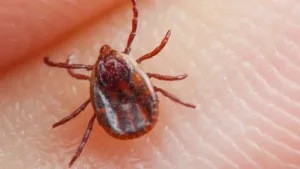Tick Vaccines for Controlling Crimean-Congo Hemorrhagic Fever

Dr. Majed Hamed Al Saegh / poultry pathologist / Australia
24/ 6/ 2025
Global Experiences with Tick Vaccines for Controlling Crimean-Congo Hemorrhagic Fever: A Comparative Analysis
Introduction
Crimean-Congo hemorrhagic fever (CCHF) is an acute viral disease transmitted predominantly by the Hyalomma tick. It represents a major public health threat in Africa, the Middle East, Asia, and parts of Europe. Traditional tick control methods using pesticides have become limited in effectiveness due to the emergence of chemical resistance, environmental contamination, and implementation difficulties. In this context, tick vaccines emerge as a safer and more sustainable alternative, by reducing tick populations and interrupting the viral transmission cycle.
This review examines tick vaccine trials in several countries, including Cuba, India, and Iraq, focusing on methodologies, outcomes, and public health impacts through a review of field trials, animal models, and national vector control initiatives.
1. Cuba: Pioneering the Recombinant Bm86 Vaccine – Gavac®
Introduction
Cuba is one of the first countries to develop and use a tick vaccine based on the recombinant Bm86 antigen, extracted from Rhipicephalus (Boophilus) microplus. This vaccine, commercially known as Gavac®, has proven effective in Latin America and serves as a model for biological tick control.
Methodology
The Bm86 protein was cloned and expressed using the Pichia pastoris yeast system. The protein was purified and incorporated into a vaccine formulation administered subcutaneously in multiple doses. Field trials were conducted on cattle herds in endemic areas, and tick numbers, moulting success rates, and immune responses were monitored.
Results
The vaccine reduced tick numbers by 91–99% and also contributed to reducing the transmission of parasites such as Babesia bovis and Babesia bigemina. Significant reductions in tick attachment, egg production, and hatching were recorded.
Discussion
The Cuban experience demonstrates the potential for highly effective use of recombinant antigens under field conditions, with clear health and economic benefits. The Gavac® vaccine has been incorporated into national veterinary control programs.
Conclusion
Gavac® is one of the most successful tick vaccines worldwide and has contributed to improved livestock productivity and reduced the risk of tick-borne diseases.
Source: Gavac® publication; de la Fuente et al., Vaccine (2007)
2. India: Experience with Combination Vaccines and Native Antigens
Introduction
India has conducted extensive research into the development of tick-fighting vaccines targeting multiple species, including Hyalomma anatolicum and Rhipicephalus microplus. Efforts have focused on developing combination vaccines that combine multiple antigens to provide broad protection against multiple tick species.
Methodology
The vaccines were prepared using native protein extracts and recombinant antigens from the gut and saliva of ticks. They were mixed with immunological adjuvants such as Freund’s and administered subcutaneously or intramuscularly to cattle. The animals were then subjected to controlled tick infections to measure efficacy.
Results
The trials showed that the combination vaccine reduced tick numbers and moulting rates by up to 82%. Strong immune responses and histological changes were also observed, indicating the effectiveness of the vaccination.
Discussion
The Indian results indicate the importance of using multi-antigen formulations to combat tick diversity. However, challenges include vaccine stability, commercial production, and licensing for field use.
Conclusion
The Indian trials demonstrate the potential of combination vaccines to reduce tick populations, but transitioning from laboratory to clinical application requires further development.
Source: “Cocktail Vaccine Against Ticks,” 2022, Ghosh et al.
3. Iraq: Preliminary Immunization Studies Using Tick Egg Extracts
Introduction
In Iraq, where Hyalomma is the major source of CCHF infection, pilot studies have recently begun using indigenous vaccines based on adult tick egg extracts as a new source of antigens. These trials aim to evaluate the immune response as a starting point for developing a local vaccine.
Methodology
Hyalomma anatolicum ticks were collected from field animals. Eggs and adults were then separated, and proteins were extracted using sonication (ultrasonic crushing). The extracts were injected into rabbits, the dose was repeated two weeks later, and immunological histology was subsequently analyzed.
Results
Rabbits vaccinated with egg extracts showed stronger cutaneous and tissue immune responses than those injected with adult tick extracts. Changes included increased skin thickness and infiltration of inflammatory cells into the spleen, liver, and kidneys.
Discussion
This study demonstrates that tick egg extracts contain antigens effective in stimulating immunity. However, the lack of experiments on production animals (such as sheep or cattle) remains a challenge.
Conclusion
This experiment represents a promising first step toward developing a local tick vaccine in Iraq. The experiment needs to be expanded and implemented on a farm scale.
Source: “Preliminary Immunization Study of Hyalomma Spp.,” Mazen Mohammed Jawad et al., 2024

Comparative Summary
Country, Target Tick, Vaccine Type, Efficacy, Application Model
Cuba: Recombinant R. microplus (Bm86) up to 99% within national programs
India: H. anatolicum, R. microplus, recombinant/original up to 82% in laboratory trials
Iraq: H. anatolicum: Original egg extracts, not yet tested in livestock, Rabbit model (preliminary)
Conclusion
Tick vaccines represent a critical tool within integrated vector management strategies to reduce CCHF transmission. While the Cuban Gavac® vaccine is a successful field application model, the experiences in India and Iraq demonstrate a diversity of antigenic sources and research directions that could contribute to the development of effective vaccines tailored to endemic regions. Further regional and international collaboration is recommended to conduct expanded field trials and integrate vaccines into tick and vector-borne disease control programs.



